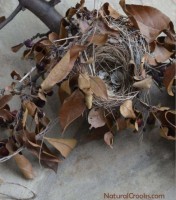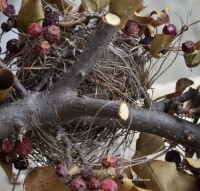While we were away this summer, a large branch broke off of our 35+-year-old crabapple tree. The tree has been dying slowly for several years. In many places the wood is rotten or hollow. So this wasn’t a big surprise, although I still wonder if the branch was helped down by someone trying to swing on it.
 One of my children watched me chopping it up to age and dry for firewood. She noticed a nest on one of the smaller branches, tucked among the leaves and sprays of tiny crabapples. It was well-made and looked like it had been used and abandoned. Shell fragments remained in the nest.
One of my children watched me chopping it up to age and dry for firewood. She noticed a nest on one of the smaller branches, tucked among the leaves and sprays of tiny crabapples. It was well-made and looked like it had been used and abandoned. Shell fragments remained in the nest.
What could have made it?
First, we started narrowing down the possibilities by asking 3 key questions: size, location and building materials?
Step 1: Nest Size
The size of a nest is often directly related to the size of the bird laying eggs in it. (Eagle nests and osprey nests are a notable exception.)
The empty nest was about 2 inches (50 mm) deep and about 3 inches (75 mm) in diameter.
This nest is too small to be made by several types of birds around here including: robins, blue jays, mourning doves, cardinals, and killdeer.
Step 2: Nesting Location
The nest was built on a tree branch, not in a tree branch. That ruled out birds that build their nests inside cavities in trees. So this nest was not built by a downy woodpecker, white breasted or red breasted nuthatch or a black capped chickadee. House sparrows also usually nest in cavities, some preferring manmade cavities in light fixtures and buildings.
The empty nest was also not built on the ground. Juncos usually nest on the ground and don’t usually stay here in the summer when this nest was most likely built. Killdeer also nest on the ground or on flat roof tops.
Step 3: Nest Building Materials
The nest is a fairly tidily built cup.
 It has some fairly thick blue plastic thread woven into it and a bit of garden twine partly woven into the nest, partly dangling down. It is lined with noticeably human hairs. (Long ones that look suspiciously like mine!) Most of the nest itself is grass.
It has some fairly thick blue plastic thread woven into it and a bit of garden twine partly woven into the nest, partly dangling down. It is lined with noticeably human hairs. (Long ones that look suspiciously like mine!) Most of the nest itself is grass.
If I hold the nest up to the light, I can see through it easily. However, this is several months after it was in use and the grass Is totally dry now.
The nest walls are not full of mud, like a robin’s nest.
Our chief contenders therefore were:
- chipping sparrows
- goldfinches
- house finches
- song sparrows
These are all smaller perching birds, who might fit a nest this size. All of these types of birds have been seen here before. And they all build cup-like nests.
In this immediate neighbourhood, chipping sparrows and goldfinches are very common. House finches, though common once, are not very common right now. I have not heard or seen any song sparrows close to here this summer.
House finch nests are usually wider than the nest I found.
Song sparrow nests are also wider than the nest I found. They often have bark on the outside, too, which my nest did not have.
The goldfinch nest is described by Cornell University as “often woven so tightly that it can hold water.” That doesn’t sound like the ideal description of this nest. Although the size is comparable, a goldfinch nest is usually lined with downy plant material. This one wasn’t. It’s also often built where three branches make an inverted tipi shape. This one, again, wasn’t.
The chipping sparrow nest is described by Cornell University as “of such flimsy construction that light can be seen through it.” Sounds familiar! The size is in the correct range. It’s common for chipping sparrows to line the nest with animal hair, and, hey, I like to party. The nests have been seen in crabapple trees before.
And the Winner Is?!
So my best guess is that the nest was made by a chipping sparrow.
Join In
Do you agree? Or do you have a different idea about what mystery bird built this nest? Please share your opinion with a comment.
Further Reading:
An excellent source of online bird information, from photos to calls to nests and behaviour, is the Cornell University Lab of Ornithology website: All About Birds.org

i don’t know. I just found a wee, tiny cup nest made from grass yesterday. It’s just a bit over 2″ in diam. It was attached to a branch, probably coming from the high trees above me. I found one just like this not that long ago, and it fit all the criteria for hummingbird nest, so that’s my conclusion. This new one too seems just the same and is only fractionally larger. Truly, only a TINY bird could have gotten into this and raised her family. I’m in upstate NY. Don’t know from chipping sparrows, but i’ll look them up. I enjoyed the story of your experience.
If the outside of your nest is covered in lichens and spider webs, it may be a ruby-throated hummingbirds but they are extremely small. Either way, it’s always very interesting to get these chances to see more about the quiet life of nearby birds!